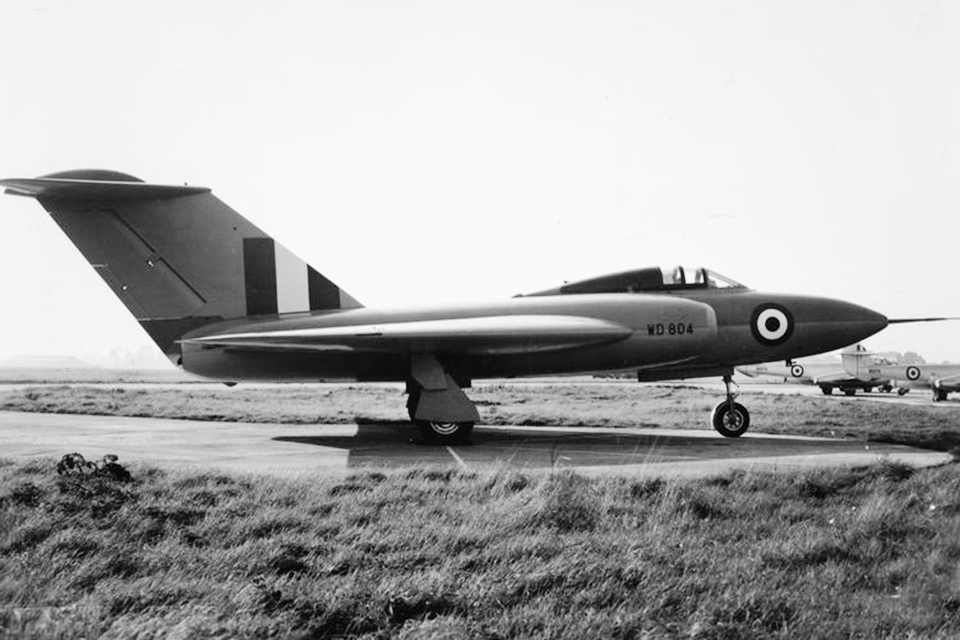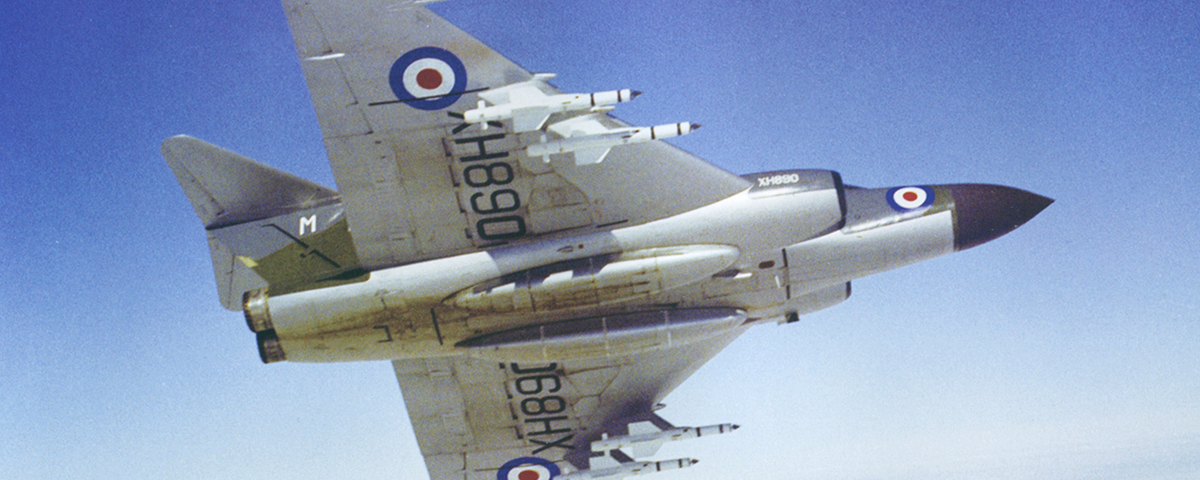The RAF’s only delta-wing fighter was also Gloster’s swan song.
“A loud bang followed by a shroud of black acrid smoke billowing from beneath the aircraft” is how one airman described an engine start on a Gloster Javelin, the world’s first twin-jet aircraft built on a delta platform and the RAF’s only delta-wing fighter. Even worse was an engine start following two failed attempts, dubbed a “wet” start; that was basically a contained explosion, with yards of flames shooting from the engine.
The Javelin was Gloster’s response to a British Air Ministry specification for a two-seat fighter-interceptor, capable of 525 knots at 40,000 feet. Gloster’s original proposal included a unique recoilless gun that fired a 3.7- or 4.5-inch cannon shell. When fired forward, the gun simultaneously fired a counterweight of equal mass backward, eliminating stress on the airframe caused by recoil loads. The Air Ministry later changed its specification to a two-seat interceptor fighter with night-fighting and all-weather capability. Four air-to-air missiles and four 30mm Aden cannons were to be installed, making the original gun redundant.
Four Javelin prototypes were ordered, with the first scheduled to fly in December 1950. With the plane weighing in at a hefty 32,000 pounds, Armstrong Siddeley’s Sapphire engines won out over Rolls-Royce’s offerings because they provided an additional 500 pounds of static thrust.
In April 1949, an “instruction to proceed” was issued for four flying prototypes and one for structural testing, but in November that was cut to two prototypes. The government continued to waffle until it became obvious that it would be impossible to do all the testing with only two aircraft. In March 1951, the order was changed again, to five standard aircraft and one trainer prototype. The additional changes resulted in massive delays.
The Gloster design team, led by George Carter, originally believed that a delta tailplane would be necessary for maneuverability at high speed and control at low speed. But North American F-86 Sabre test data showed that conventional elevators were very effective in both speed ranges. As a result, the Javelin was equipped with a modified trimmable tailplane with conventional elevators.
Gloster’s chief test pilot, Squadron Leader Bill Waterton, and Jan Zurakowski were assigned to the Javelin project (Zurakowski later left Gloster to work for Avro Canada). On November 26, 1951, Waterton—piloting prototype WD804—took off from Moreton Valence, accompanied by a Meteor chase plane. Immediately after takeoff, Waterton reported severe airframe vibration that increased at higher speeds. He thought the problem had something to do with the rudder, a guess that was confirmed by the pilot of the chase plane, who noted rudder buffeting. Waterton landed only 34 minutes after taking off. Oil from the engines had left streaks on the tail, clearly indicating the shape of the airflow. To cure the problem, the prototype was modified to incorporate an extension to the rear fuselage, creating a distinctive “pen-nib” tail cone.
In mid-1952 WD804 was lost during its 99th flight when the elevators developed serious flutter, then broke away. Waterton somehow succeeded in getting the plane back to Boscombe Down, landing by using the tailplane trimmer for pitch control. But he was forced to land at a much higher speed than normal, and the undercarriage collapsed. Although the prototype caught fire, Waterton managed to escape unhurt—and even saved the flight data, for which he was awarded the George Medal.

The second prototype, WD808, first flew on August 20, 1952, and Waterton subsequently demonstrated it at Farnborough. Despite limitations imposed on the demo (the cause of the WD804 crash had not yet been determined), he wowed the crowd with a low-level, high-speed routine.
On March 7, 1953, Waterton began testing the third prototype, WT827, which was equipped with operational armament of four Aden guns and air intercept radar. High- altitude tests on the first two prototypes had shown that high-speed handling characteristics could be improved by modifying the outer wing. From just outboard of the guns, the leading edge sweepback was reduced, giving the wing a “crank” appearance. A modified set of cranked wings was installed on WD808 on May 28, 1953.
During stall tests on June 11, with Peter Lawrence at the controls, a “deep stall” condition developed, a situation where the aircraft’s nose pitches up and forward speed decreases. Lawrence stayed with the Javelin, continuing to radio updates about the aircraft’s responses until he finally ejected at low altitude. Sadly, he died after his parachute failed to deploy completely.
Wind tunnel tests subsequently confirmed that at high angles of attack, the Javelin’s wing blanketed airflow over the tail assembly, rendering the plane uncontrollable. No practicable solution was found, however, and Gloster deemed that the problem could be avoided if pilots had sufficient warning. The wings were then equipped with stall sensors, which provided an audible warning for pilots.
The fourth Javelin built, WT830, was intended as a stress research aircraft, fitted with the new wing and fully powered ailerons. The final prototype, WT836, was the first equipped with what was to become the standard twin Perspex hoods.
The official production order for the Javelin came in mid-1953, while Gloster was still producing Meteors. By 1954, the Javelin program was receiving lots of criticism, some of which focused on the aircraft’s supposed inability to exceed the speed of sound—though that requirement had not been part of the specs.
Waterton, who was by then working as a newspaper correspondent, claimed it was impossible for the Javelin to break the sound barrier. But on the night of July 4, 1954, many Londoners heard from the Javelin. The minister of supply later explained to the House that “the aircraft was cruising at high altitude, near the speed of sound when the pilot’s oxygen supply failed; during the ensuing confusion he inadvertently exceeded the speed of sound, causing the bang.” The pilot who had reportedly “suffered from oxygen starvation” was Waterton’s successor as chief test pilot, Wing Commander “Dicky” Martin.
The first Javelin Mark 1 (XA544) flew from Hucclecote on July 22, 1954. Together with the third production plane, it was demonstrated before crowds at Farnborough that September. The following month a story circulated that a substantial number of Javelins, costing nearly £40 million, were to be purchased by the U.S. Air Force as part of the Mutual Defense Aid Program. In reality, no such order was ever received.
October 1954 brought bad news. During a spin test, another Javelin crashed, this time into the Bristol Channel, costing the life of Flight Lt. R.J. Ross. Following that incident, the government opted for a presquadron operational tryout. In 1955 two Javelins took part in Operation Beware, an annual air defense exercise. They reportedly performed well, claiming to have made interceptions more than 100 miles from Britain’s coast and confirming a number of “kills” on English Electric Canberra bombers.
On February 29, 1956, the first Javelin was delivered to an operational unit, No. 46 Squadron, which adapted to its new mounts with little difficulty. A second squadron, No. 141, was reequipped one year later.
Although the Javelins were then designated FAW (fighter all weather), indicating they were ready for service, in actuality they were still not armed with missiles, and many limitations had been placed on the flight envelope. Meanwhile the design continued to evolve, with a large number of each mark used in various trials. The FAW 8—an FAW 7 with “reheat,” or afterburning—appeared so quickly that 80 FAW 7s never even saw service (they were eventually converted to FAW 9s).
Reequipping night fighter squadrons with Javelins enabled the RAF to take over the night standby duties of Operation Fabulous from the U.S. Air Force. That mission called for two aircraft to be positioned at the end of a runway with the crews in their seats. The planes were equipped with a telebriefing system: a land line from the briefing office connected to a plug inside the port wheel bay. The lead was incorporated into the port wheel chock and disconnected automatically as the aircraft moved off. Two more aircraft stood by, with crew changes every hour.
The Javelin’s 927-square-foot wing area provided an extremely stable weapons platform. In June 1960, a Javelin fired a Firestreak missile, successfully downing its Meteor drone target. The aircraft’s only “kill” came in Malaysia, where a Lockheed C-130 that the Javelin had been sent up to intercept crashed in an effort to avoid a collision.
With a ceiling of 52,000 feet and an airspeed of Mach 0.9 at altitude, the Javelin more than met specifications. Pilots loved its roomy cockpit and appreciated the amount of available weaponry. But the design’s protracted development period and the lack of opportunity to prove itself in combat resulted in an undeserved flawed reputation.
Some 436 Javelins were built before the aircraft was gradually replaced in British frontline service by the Mach 2 English Electric Lightning in 1964. Javelin variants served throughout Europe and the Far East from 1955 until 1968.
The Javelin was the last aircraft produced by Gloster, which in 1961 merged with Armstrong Whitworth to form Whitworth Gloster Aircraft Limited. Two years later it became part of Hawker Siddeley Aviation’s Avro Whitworth Division. Its production efforts were later siphoned off to nonaviation projects, including vending machines.
This feature originally appeared in the May 2008 issue of Aviation History. Subscribe today!





